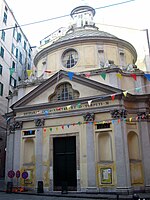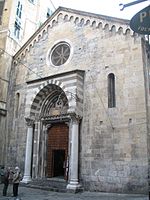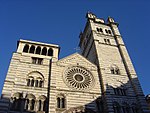Embriaci Tower
12th-century establishments in Italy12th-century establishments in the Republic of GenoaBuildings and structures in GenoaGenoa

The Torre Embriaci, also called Torre degli Embriaci, located in the oldest area of Genoa, where the Castello o Castrum stood. It is the only one of the numerous towers that were located in the current historic center of Genoa to have been spared by the edict of 1196 which wanted to cut all the city towers to 80 palms.
Excerpt from the Wikipedia article Embriaci Tower (License: CC BY-SA 3.0, Authors, Images).Embriaci Tower
Salita alla Torre degli Embriaci, Genoa Centro Est
Geographical coordinates (GPS) Address Nearby Places Show on map
Geographical coordinates (GPS)
| Latitude | Longitude |
|---|---|
| N 44.4059 ° | E 8.9293 ° |
Address
Salita alla Torre degli Embriaci 4
16123 Genoa, Centro Est
Liguria, Italy
Open on Google Maps











